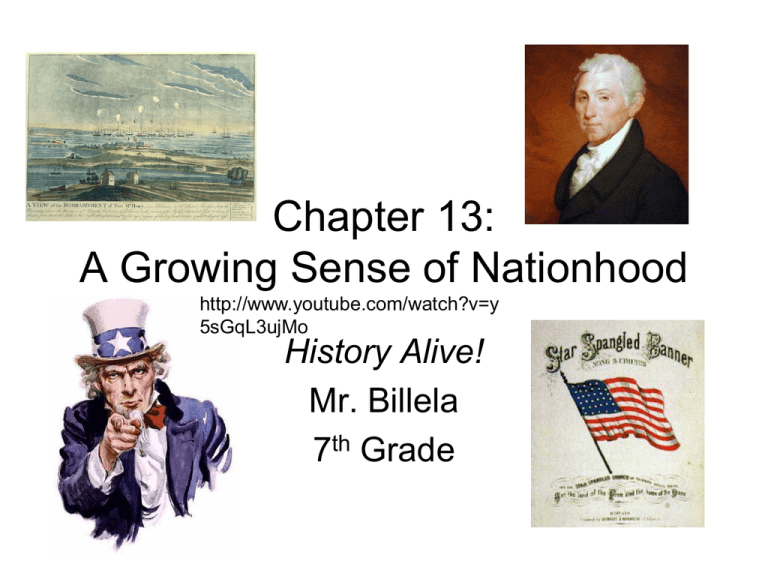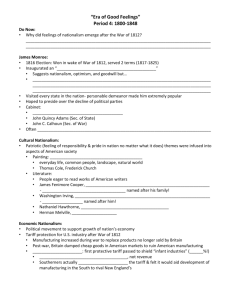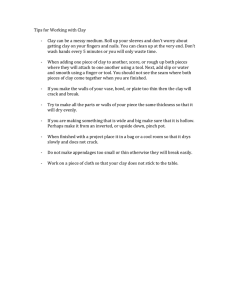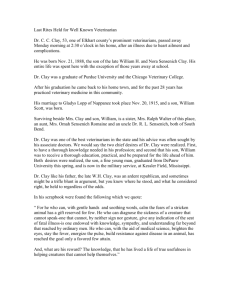Chapter 13: A Growing Sense of Nationhood
advertisement

Chapter 13: A Growing Sense of Nationhood http://www.youtube.com/watch?v=y 5sGqL3ujMo History Alive! Mr. Billela 7th Grade Star Spangled Banner An inspiring moment that gave us our identity… • Battle of Baltimore came right after Washington, D.C. was set on fire. • British moved in to Baltimore Harbor and bombarded Ft. McHenry. • Francis Scott Key was aboard a British vessel being held until the morning. • Knew that if the flag came down, we were sunk. • After a whole night of bombardments, the flag was still there (flag is 30 x 42 feet)! A Land of Differences • After the War of 1812, a surge of patriotism followed. • 2 out of 3 Americans still lived on the east coast, within 50 miles of the Atlantic. • Regional stereotypes formed: – Northern “Yankees” hard working, thrifty, quick to chase a dollar – Southern plantation owners gracious, cultured, and lazy – Frontiersmen (to the West) rugged, hardy, and crude Symbols and Values • Congress hired architects to rebuild the White House • Uncle Sam as a cartoon figure appeared throughout print media as a good guy • Americans devoted to individualism and equality (unless you were a slave, Native American, or a woman) The Era of Good Feelings • James Monroe was elected in 1816 and ran unopposed 4 years later. • Nationalism: the swelling of pride for one’s nation • Capitalism: an economic system in which individuals and companies produce goods for profit. Henry Clay • From Kentucky • Was a “War Hawk” • Ran for President 5 times, saying “I’d rather be right than President.” • Believed in capitalism • Created The American System: – High tariffs to protect American jobs – Use tariff $ to build American roads and canals – A new National Bank to provide credit • Clay’s system used tariff money to build these roads and canals. John C. Calhoun • From South Carolina • Supported Clay’s American System, including the new National Bank • But by the 1830’s he would become the leading spokesman for states’ rights, to protect slavery in the South. • Biggest spokesman for nullification. Daniel Webster • From Massachusetts • Unlike Clay, bitterly opposed the War of 1812 • After the War, supported Clay’s American System • “Let us act under the settled conviction…that these 24 states are one country.” • Challenged Calhoun about nullification American Art • Hudson River School: America’s rich landscape became the subject of much art. • Storm clouds, sunny skies, glowing light, as if God were smiling on America • Nature more interesting than people Art, continued… • John James Audubon painted 435 finely detailed portraits of birds. • Accurate and realistic • George Catlin painted Native American villages, rituals, people American Music • North: classical music from Europe (cotillion: four couples dance with coordinated movements) • South: spirituals, songs by slaves; square dancing, and minstrel songs, which honored black music by mimicking it American Literature • James Fenimore Cooper’s The Last of the Mohicans • Davy Crockett: King of the Wild Frontier The End of an Era • In 1824, four candidates (including Clay) competed to succeed Monroe as president. • None of them won a majority in the Electoral College. • The House of Representatives chose John Quincy Adams, the son of John Adams. • Partisan strife was back, and here to stay.











![[1.1] Prehistoric Origins Work Sheet](http://s3.studylib.net/store/data/006616577_1-747248a348beda0bf6c418ebdaed3459-300x300.png)